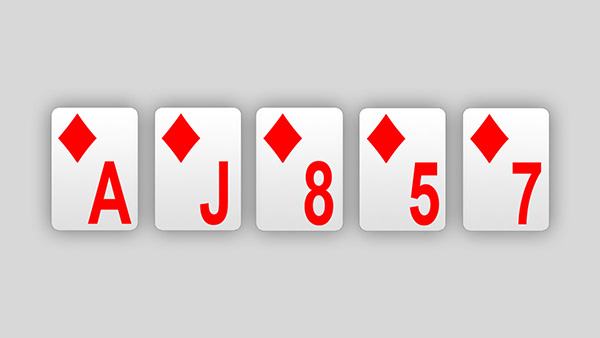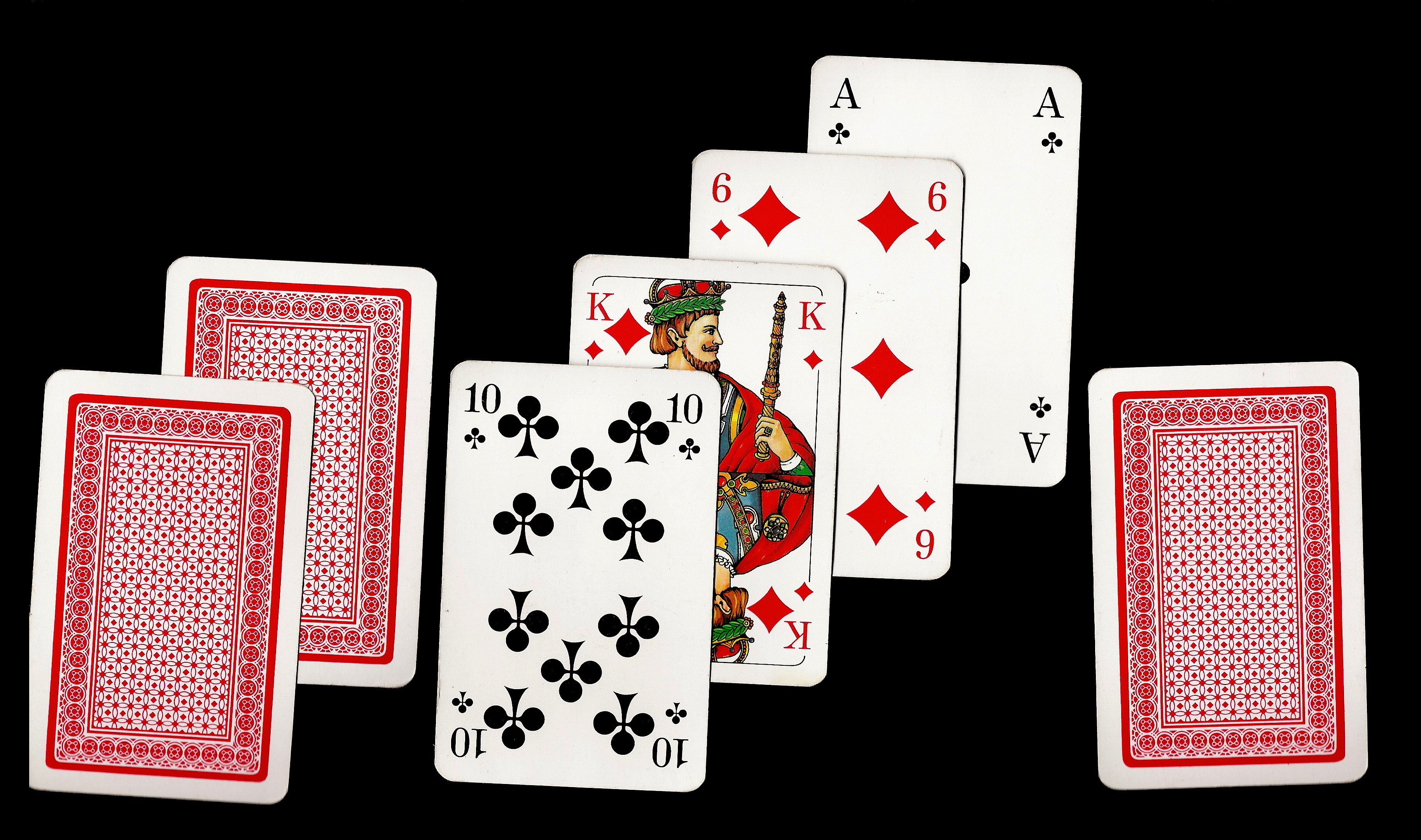When the poker boom hit in 2003 after Chris Moneymaker famously won the World Series of Poker Main Event, Texas Hold ‘em was all the rage. But for many in the years prior, their introduction to poker came through a very different game.
The order in which Texas Hold’em is dealt is very specific and, assuming you’re playing with a table full of lucid, honest people, never changes. First, you are dealt two hole cards. Then comes the flop, turn and river cards. The flop After a round of betting for the hole cards, a card is burned. In poker, players form sets of five playing cards, called hands, according to the rules of the game. Each hand has a rank, which is compared against the ranks of other hands participating in the showdown to decide who wins the pot. In high games, like Texas hold 'em and seven-card stud, the highest-ranking hands win.
Five Card Draw has always been one of the games that people would play around the house or at parties. For anyone that didn’t know how to play poker, the simplicity of the rules made it an easy variation of the game to start with.
It is one of the earliest forms of poker on record. In addition, it is one of the most famous as any movie that poker was a part of in the pre-poker boom era most likely featured Five Card Draw.
Five Card Draw is the game believed to have been played during the days of the Wild West when “Wild” Bill Hickok was famously shot to death while playing. As legend has it, he was holding two pairs, Aces and Eights, a hand that is now nicknamed “The Deadman’s Hand” due to this ominous occasion.
The game is no longer spread in brick and mortar casinos unless requested. Online you can find plenty of games, however. Luckily, if you’ve never played before, Five Card Draw is one of the more basic and straightforward forms of poker.
The best place to start when discussing the basics is the hand rankings. Before diving into how the game is played it is important to know what constitute a good hand so that you can determine what you should do when it is your turn to draw cards.
Five Card Draw follows the same high hand guidelines as all of its fellow poker game variants. To understand the hand rankings of a poker game take a look at the graphic below:
Five Card Draw will usually be played 6-handed. Because of the draw nature of the game, anything more than 6 and you risk not having enough cards in the deck to cover everyone’s draw.
The hand will start in one of two ways depending on the betting structure being used. In Five Card Draw you will sometimes see it played where everyone posts an ante, but the more popular way and the way that you will see it played online is that there will be a small blind and a big blind.
If you’re familiar with Texas Hold ‘em or Omaha than you know this format quite well. If you are new to poker entirely here is what we mean by small blind and big blind:
- Small Blind
- The small blind is the first forced bet by the first player on the direct left of the dealer. The amount of the small blind will be half of the big blind, which is considered the full bet amount.
- Big Blind
- The player to the direct left of the small blind will post the second forced bet known as the big blind. This big blind amount constitutes a full bet.
Once the blinds are posted the dealer deals each player five cards face down.
At this point, the first round of betting occurs, starting with the player on the direct left of the big blind. Once this round of betting has completed it is now time for the players to draw.
The Draw
The “draw” in Five Card Draw is the heart of the game. After the first round of betting, players have the option to discard cards they do not want and draw new ones from the top of the deck.
If a player likes the first five cards they were dealt they can choose not to draw any cards. This is known as “standing pat”.
After each player left in the hand has had a chance to discard and draw new cards, another round of betting occurs. After this final round of betting the remaining players table their hands and the player with the best hand is declared the winner.

The betting structure of Five Card Draw resembles that of Texas Hold ‘em. Each hand starts with a small blind and big blind posting their bets. The game can either be played in the fixed limit structure, or the no limit structure.
In fixed limit Five Card Draw, betting is done in increments of the big blind equivalent. In no limit Five Card Draw the only limitation to how much you can bet is the amount of chips in your stack.
Overview
By now you have found that the rules of Five Card Draw are fairly simple and straightforward. A quick recap of the game sequence is as follows:
- Each player is dealt five cards.
- A round of betting, starting to the left of the big blind occurs.
- Players discard the cards they do not want and draw new cards
- A round of betting starting with the first live player to the left of the dealer.
In Five Card draw you will most likely always be drawing cards. It is fairy rare to be dealt an extremely strong hand on the first deal.
For reference, take a look at this mathematical chart below of the chances of being dealt certain strong hands prior to the drawing round:
- Royal flush <0.001%
- Straight flush (not including royal flush) <0.002%
- Four of a kind 0.02%
- Full house 0.14%
- Flush (excluding royal flush and straight flush) 0.20%
- Straight (excluding royal flush and straight flush) 0.39%
- Three of a kind 2.11%
- Two pair 4.75%
- One pair 42.30%
- No pair / High card 50.10%
At this point it is pretty safe to say that you have a solid understanding of the rules of Five Card Draw.
To understand the game even deeper and to get some tips and tricks on how to be more profitable at the tables check out our Guide to Five Card Draw section and best of luck along the way.
Raise First In
Our Objective
Our primary focus when playing 5-card draw should be attempting to make three-of-a-kind. We look for decent pairs and then draw 3 cards hoping to make trips. Drawing three gives us statistically the highest chance to make trips. You will often see players at your limit holding on to one of their kickers and drawing only two cards, but in most cases this is incorrect.The exception is that there are already 2 limpers in the pot, in which case it's fine to limp behind some straight-draws and flush-draws, but gut-shots should typically be folded. We don't want to make hard and fast rules here but there are some exceptions vs passive opponents where we can get away with cold-calling these hands for one of the two following reasons in a no-limit-game
- Our opponent just can't fold at showdown and hence we have great implied odds. (Note that this applies purely to no-limit 5-card draw games and it's nearly always going to be a mistake to call a raise preflop with a straight-draw or flush-draw in a limit game)
- Our opponent plays extremely face up on the final street and we can pick up pots as a bluff. (Note that again this applies more frequently to no-limit games as our opponent is less likely to fold anything to a min-bet in a limit game)
RFI Ranges
- UTG KKxxx+
- MP QQxxx+
- CO JJxxx+
- BTN 99xxx+
- SB TTxxx+ (however it's OK to complete some weaker hands with reasonable potential)
Isolating
Pairs lower than JJxxx are referred to as “shorts” and are generally considered trouble hands in 5-card draw, so play with caution. These should often be folded preflop, but again it is somewhat villain dependent. We might be able to play some smaller pairs as limp-behinds and take the opportunity to turn them into a bluff on the river vs face up opponents.
The Draw
- If we have a pair we draw 3 and try and make trips.
- If we have trips, we draw two and try to make Quads or a boat.
- If we have a flush-draw or straight-draw we draw one and try to hit.
- If we have total garbage (usually in a free play situation) we can hold on to cards above a Queen or Jack and replace the others.
Hand Reading

3 cards – In most cases this will indicate that the player has a pair and is trying to pick up three-of-a-kind. A very bad player might be drawing to a flush or straight with only 2 cards. It's always worth taking a note of this kind of thing if you discover at showdown that the player drew 3 cards and does not even have a pair when he shows down.
Showdown
Advanced Tactics
Free 5 Card Hold'em Poker

Our opponent will often call with 2-pair in this situation hoping to either beat our 2-pair or bluff-catch against our busted draws. In other words, drawing 1 allows us to represent a weaker range with a strong hand. Note that this only makes sense against semi-decent opponents. The average fish may not even care how many cards we draw, in which case we should always draw 2 with trips and give ourselves the maximum chance of improving.
Our opponent will usually fold unless he improve to trips or better. And even if he has trips it won't theoretically be a correct call unless he expects us to be bluffing like this since we are representing a 5-card hand which beats his trips. Obviously we have to be careful not to over-use this line. If we stand-pat every hand it's going to become obvious pretty quickly that we don't have anything.
Using Position to Bluff
- They would lead for value if they hit a strong draw
- They would lead for value a decent amount if they had 2 pair
- It's overall pretty unlikely that they'll spike their draw
So if our opponent has a tendency to go for hugely unlikely draws then we can defend much wider in position even with some weak hands ourselves. We might not get the pot-odds to defend the hand, but if our opponent simply check folds final-street every time he misses, our preflop odds don't matter.